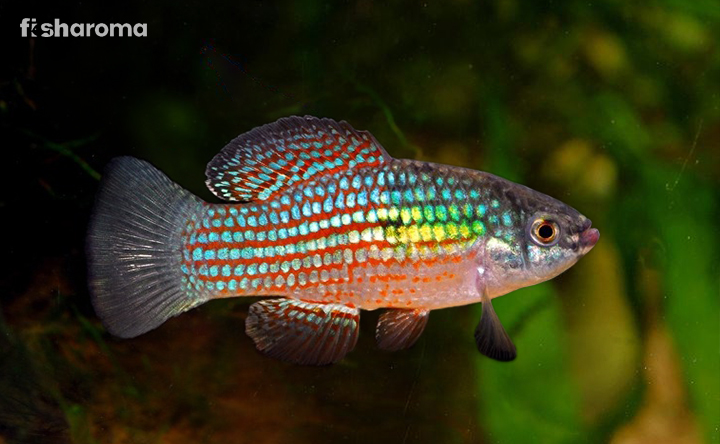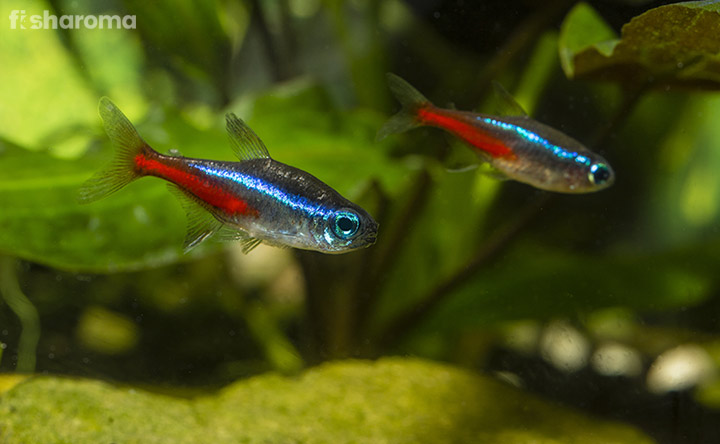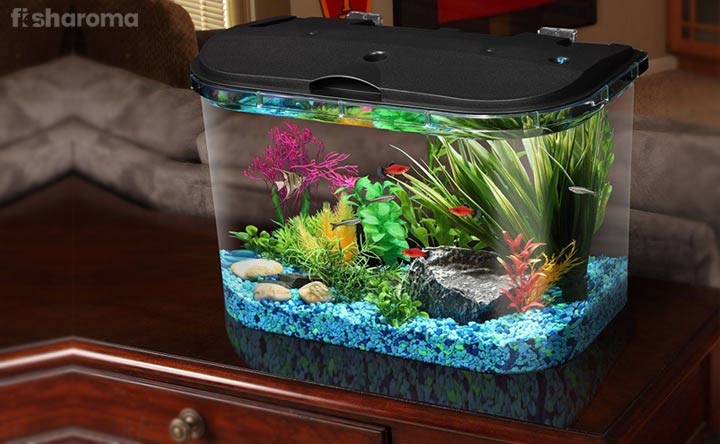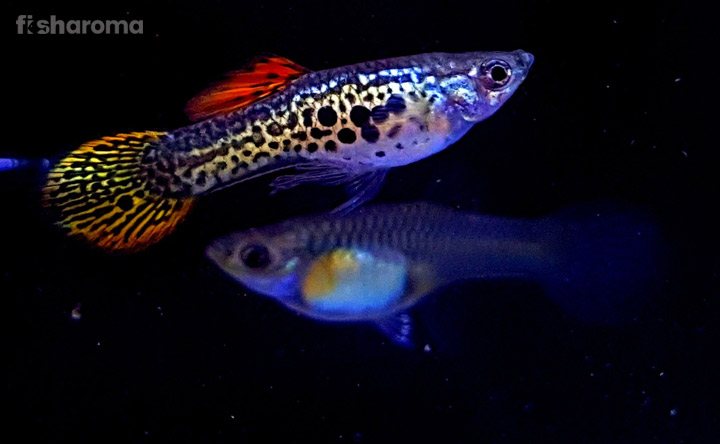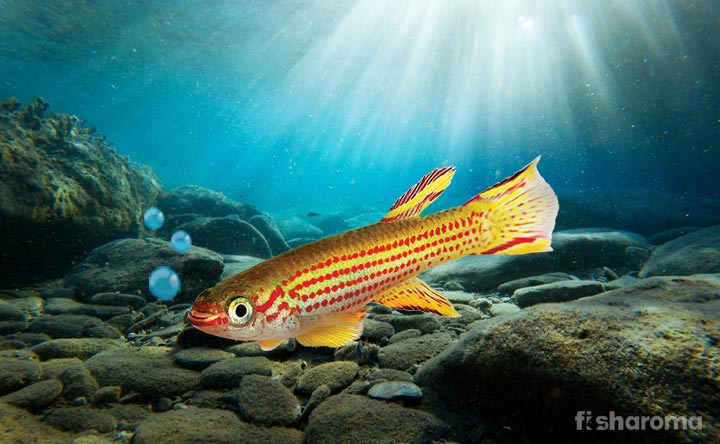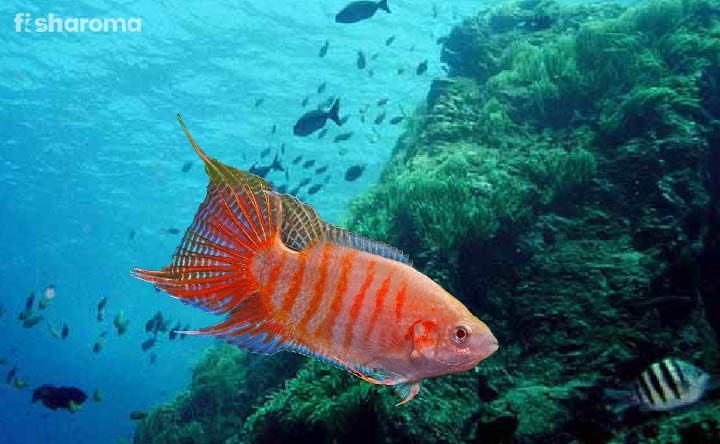Dwarf Gourami – The Complete Care Guide for this Little Tropical Pet Fish

- Origin and Habitat of Dwarf Gourami
- Appearance of Dwarf Gourami
- Types of Dwarf Gourami
- Diet Plan for Dwarf Gourami
- Tank Requirements for Dwarf Gourami
- Water Type for Dwarf Gourami
- Temperament of Dwarf Gourami
- Suitable Tankmates for Dwarf Gourami
- Breeding Process of Dwarf Gourami
- Diseases of Dwarf Gourami with Intervention
Dwarf Gourami looks like a drop of paint in an aquarium. Its small size and multicolored or bicolored body look like a splash of rainbow colors in a fish tank. Watching this cute little multiple-shaded fish is soothing to your eyes and relaxing to your mind. This hardy and adaptable fish is very easy to grow. Its complete care guide will help you take care of the fish like a pro.
Quick Details on Dwarf Gourami
There are lots of facts to know about Dwarf Gourami. So, before going to the depth of the care guide, let us go through a quick detail of the fish.
| Scientific Name | Trichogaster lalius |
| Origin | India (Assam, West Bengal), Pakistan, and Bangladesh |
| Life-Span | Up to 5 years |
| Colors | Blue, Orange, Red, Bicolor, Tricolor, Multicolor, etc. |
| Temperament | Peaceful |
| Size | 2-4” (5.08-11cm) |
| Diet | Omnivore |
| Family | Osphronemidae |
| Compatibility | Compatible with Peaceful and Social Species |
| Tank Size | 5-10 gallons |
| Care Level | Easy |
Overview
This little member of the Gourami family is also known as Flame Gourami. Fishkeepers like to pet this fish because of its low-maintenance nature. Moreover, this fish can fit anywhere because of its size.
Dwarf Gouramis always like swimming with a school of fish. Living in a shoal makes them feel secure and comfortable. Sometimes they are found swimming on the top level of the water, and sometimes they are found in the mid surface of the water. You should expect to pay around $4 to purchase this fish.
Dwarf Gourami is known as a labyrinth fish, as they breathe with a lung-like labyrinth organ straight from the air.
Origin and Habitat of Dwarf Gourami
This majestic looking fish was usually found in the slow-flowing rivers, rice fields, ponds and lakes of Southern Asia. Nowadays, it is found near the rivers of Columbia, Singapore, and the USA.
Most of the Dwarf Gouramis are native to the streams and rivers of Northern India and Eastern India (West Bengal and Assam), Bangladesh and Pakistan.
You will find them with other Colisa species. This fish is one of the most common fish breeds in the river plains of Asian regions. You will find them in thickly vegetated water.
Appearance of Dwarf Gourami
The name ‘dwarf’ fits well with this Gourami fish because it cannot grow more than 2-4” (5-11 cm). The male fish is slightly larger than the females. Most of the fish have bright orange-red body and turquoise-blue vertical stripes on their fins and tail. Some of them are neon, powder blue, and rainbow shaded. Dwarf Gouramis carry touch-sensitive cells on their thread-like pelvic fins.
The male fish has pointed dorsal fin and the females have round dorsal fins. The male Gouramis are vibrant than the females. Moreover, the males develop elongated anal and dorsal fins and the females have short and circular shaped fins and tail.
Types of Dwarf Gourami
Not only one, but there are various types of Dwarf Gouramis that differ in colors, shapes, and patterns. You will get a variety of Dwarf Gouramis; you just need to decide which one you want to add in your fish world. Let us enhance our ideas on the various types of Dwarf Gouramis:
- Powder Blue Dwarf Gourami: This Dwarf Gourami has a light-blue shaded body and orangish lines on its body. The scales of this fish are solid metallic in color.
- Blue Dwarf Gourami: This dark-blue fish has reddish-brown lines that run on both the sides of its body and fins. The fins also have light brownish edging. The scales of this fish are large and easy to recognize because they are located close to each other.
- Neon Blue Dwarf Gourami: The color of this Dwarf Gourami is neon blue. It is the brightest fish in the Gourami family. You will find some red stripes running on the body of this fish. Splash of blue and red color is mixed on its fins.
- Honey Dwarf Gourami: The entire body of this Gourami is light honey-orange shaded. The caudal fins of the fish are colorless and transparent. You will find dark patches on the scales of this fish.
Diet Plan for Dwarf Gourami
This Gourami fish is a natural-born hunter because it has an interesting technique to find its prey. This fish swims up to the surface of the water to spot its prey. This species traps insects by hitting it with a spray of water and the insects fall in its trap, unfortunately.
Well, that was about the wild life. When you are keeping this fish in your aquarium, you need to choose some of its favorite foods such as:
- Algae
- Tube Worms
- Blood Worms
- Brine Shrimps
- Edible Leaves
- Vegetables
Feed them vitamin content and balanced nutrient which will help them grow fast. Feed them twice or thrice a day. You can feed frozen and artificial foods also to Dwarf Gourami that are diverse and nutritious diet by nature such as:
Tank Requirements for Dwarf Gourami
As we have discussed earlier, Dwarf Gourami prefers living in slow-moving rivers, streams, lakes, creeks, canals, and ponds. During monsoon, these fish are seen swimming on the upper surface of the water within their territories.
Dwarf Gourami prefers living in a natural habitation, and it is adaptable to both warm and cold water. However, there are some other factors that you should consider while setting a tank for the fish.
Tank Size
Minimum a 5-gallon tank is required for a Dwarf Gourami. If you are keeping 2-3 Gouramis, then a 10-gallon tank is required.
Ornament
Gouramis like the natural environment, so you can adorn the fish tank with live fresh plants, small caves, well-rounded sand grains, and small dark gravels so that the fish enjoys the eco-friendly ambiance in captivity.
The free-floating and drifting plants like Hornwort and Duckweed are the best choices for ornamenting its tank. Moreover, Gouramis use those plants to build their nests in larval development stage and hides behind the plants. You can also keep some woods or ceramics in the tank so that the shy fish can hide whenever required.
Lighting
Dwarf Gourami does not like much light in its aquarium. You can keep a dimmed aquarium lamp in the tank, and switch on the light for 8-10 hours.
Filter
The intensity of filtration will depend on the number of aquatic plants kept in the aquarium. You can keep a medium-powered filter because Gouramis prefer dwelling in slow-moving water.
Water Type for Dwarf Gourami
Like human beings, every living thing wants a safe and healthy environment. So, water is the home of the fish, and you have to keep their home clean and fresh. Along with clean and hygiene management, maintain the water parameter for the survival of the fish.
Temperature
The temperature range of the tank of Dwarf Gourami should be 77-78.5°F (25-26°C).
pH Level
The pH level of the water of the aquarium should be 6-8.
Hardness
The water hardness should be 10-20 dGH.
Cleaning Method
Dwarf Gourami is a very sensitive fish, and it may get sick due to some pollutants in water. So, you need to clean the tank once a week by using soft liquid soap and a brush. After scrubbing and washing the tank, wipe the body, corners, and edges of the tank with a white cloth.
Replacement Process
Try to change about 25% of the water every week because Dwarf Gourami cannot live in dirty water. A clean environment will help the fish stay healthy and grow fast.
Temperament of Dwarf Gourami
Fish hobbyists often look for a beautiful and peaceful fish at the same time for their tank. Dwarf Gourami is an ideal combination of beauty and non-aggressive nature.
While keeping such passive-natured fish in your tank, you have to find out ideal tankmates for your pet fish. Aggressive predator fish can fight and eat the fish.
Suitable Tankmates for Dwarf Gourami
This fish is a tolerant and calm-natured neighbor in the aquatic world that never harms any species. It is better to keep this fish with same-sized species that have similar water chemistry requirements.
The ideal tankmates of Dwarf Gourami would live in the middle and bottom level of the aquarium. Find such tankmates that will neither bully them nor disturb them while building their nests in the tank. Some of the suitable companions of Dwarf Gourami are:
- Mollies
- Swordtails
- Platies
- Rasboras
- Loaches
- Catfish
- Tetras
- Plecos
- Amano Shrimp
- Mystery Shrimp
Unsuitable Tankmates
Avoid keeping notorious fish which can bully Dwarf Gourami. Moreover, never keep fin nippers, aggressive fish and large predators with this little adorable fish. Here are the names of some unsuitable tankmates for Dwarf Gourami:
- Barbs
- Oscar
- Sharks
- Arowanas
- Bettas
Compatibility of Dwarf Gourami
Dwarf Gourami prefers living with a school of Gouramis like Sparkling Gourami and Paradise Gourami. Moreover, this fish enjoys swimming in a pair. You can keep 3-4 Dwarf Gouramis together, but maintain the ratio of male and female. Try to keep a couple of females for every male Gourami.
Breeding Process of Dwarf Gourami
The breeding process of Dwarf Gourami is very simple. Just maintain the water condition and environment for their breeding. Arrange a separate tank for a comfortable breeding process. The breeding tank can be a nano tank. The bottom of the tank should be covered with a thin layer of sand, and some freshwater plants should also be kept inside the tank.
Dwarf Gouramis become sexually mature at the age of six months, and during that time, the males start making nests with saliva and foam before the mating process. The breeding season of this fish is monsoon season.
To stimulate the breeding process, the temperature of the water should be 82.5-86°F (28.05-30°C). Keep the parameter of water in the same range. Once the nest is constructed, this fish starts the spawning process. After that, the females release various eggs and the males quickly catch the eggs and place them into a nest. When the spawning process is completed, the females should be transferred back to the main tank.
The newborn fries will live in the nest for some days after fertilization. When the fries leave the nest, the male fish should be transferred to the main tank. You can feed newborn shrimps, small Bloodworms, Infusoria, Daphnia and Cyclops to the newborn Dwarf Gouramis. When the fries reach 0.6-08” (1.52-2.03 cm), you can transfer them to the main tank to their parents.
Diseases of Dwarf Gourami with Intervention
The water temperature range in the tank of Dwarf Gourami needs to be maintained, otherwise, the labyrinth organ of the fish may get harmed and they cannot breathe properly. Due to the water pollution and sensitivity of water, this fish can get affected by various diseases:
- Viral Infection: When you find that Gouramis have started fading color and losing their fins, then you have to understand that it is facing viral infection. This infection causes due to water pollution.
- Iridovirus in Dwarf Gourami: This is a severe infection that can cause death. Due to the weak immune and digestive system, this fish is affected by Iridovirus in Dwarf Gourami (DGIV). So, ask a good nutritionist before planning a proper diet for this fish.
- Fungal Infection: If the environment of the fish tank is not clean, then the fish may get affected by a fungal infection, and it starts rubbing its body against the objects of the tank. This condition can make the fish stressful.
Therefore, try to maintain the condition of the water and also choose suitable tankmates for the tank of the Gouramis if you want to keep them happy and healthy. If your pet fish is in a life-threatening condition, take the suggestions of a good veterinary doctor.
Well, after a long discussion about the facts, features and care guide of Dwarf Gourami, we hope that you are keen to bring the cute little pet fish to your aquarium.
Interesting Facts
- Dwarf Gouramis make bubble nests and they need surface plants for creating the nests.
- These fish get scared by the loud noise and hide as a result of it.
- Dwarf Gourami always likes to swim in a pair.
More Care Guides about Other Gouramis
We know there are multiple species in the Gourami family, but some aquarists haven’t heard the name of all Gourami Fish. To know about the different types of Gouramis, you can have a thorough look at their factors, features and care guides.
- 17 Different Gouramis: There are various Gouramis that are available in the market. Among them, we have discussed the facts and features of some popular Gourami Fish. You may have a look!
- Honey Gourami: The beautiful honey-orange color of this fish mesmerizes every fishkeeper. If you also want to keep Honey Gourami in your fish tank, then go through its care guide.
- Paradise Gourami: Are you looking for a gorgeous eye-catching fish for your aquatic world? Paradise Gourami can be the best choice if you like a beautiful freshwater buddy. Go through its care guide if you want to keep this fish in your fish tank.

